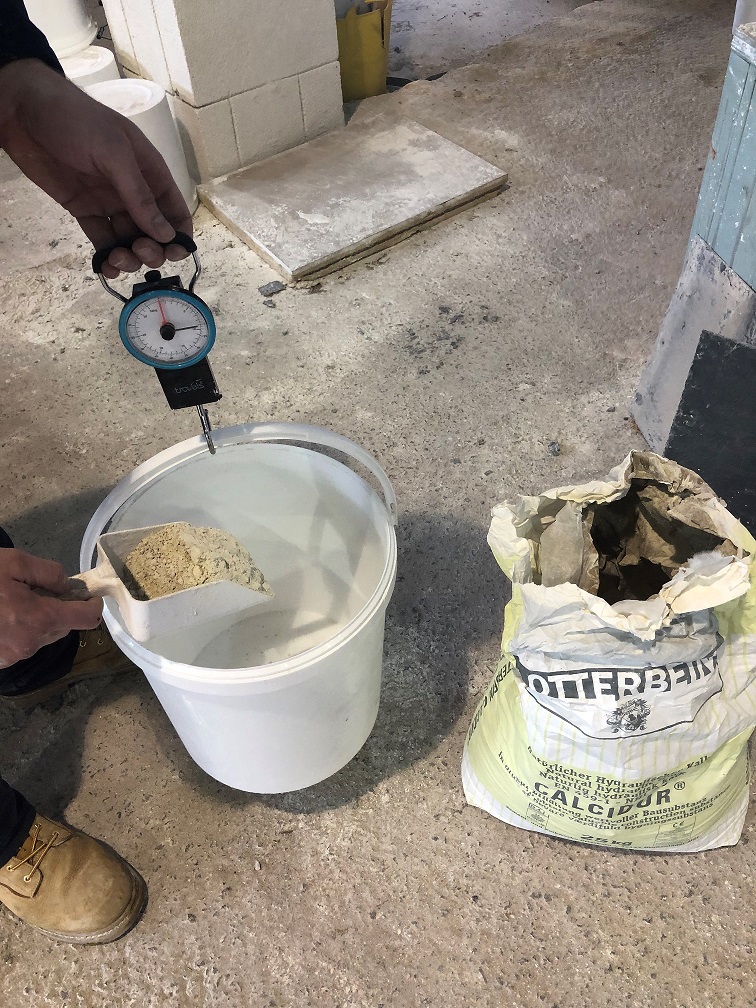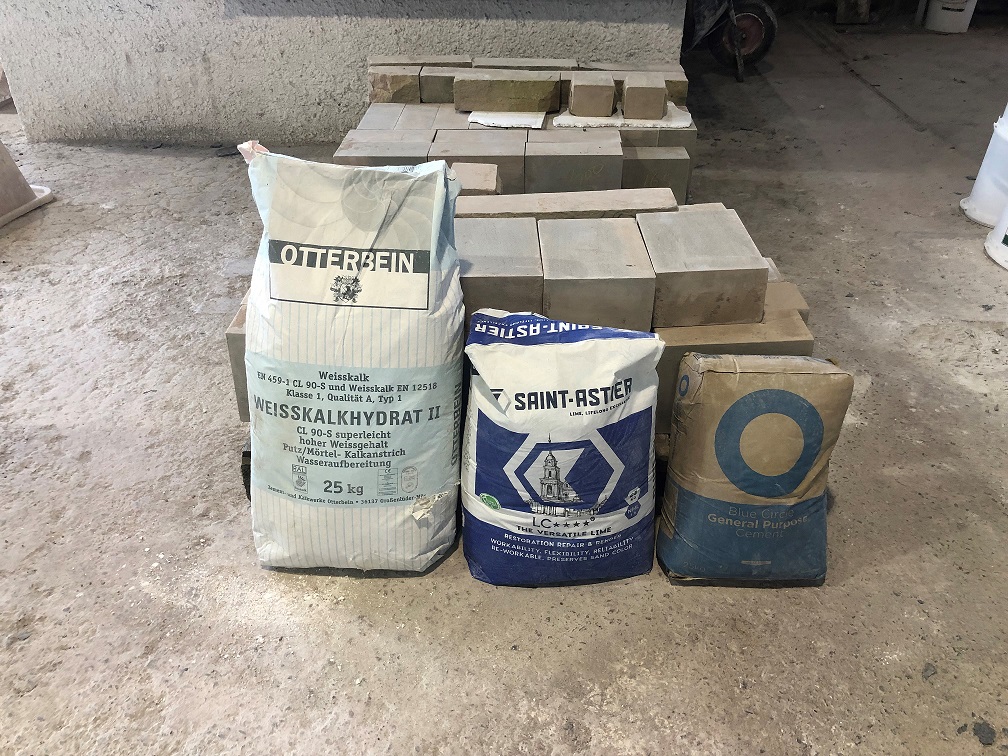Mortar Mix Ratios
A practical guide to making repeatable and consistent mortars
Roz Artis

Weighing out dry hydrate (powdered) binders is most accurately undertaken by weight not volume (All photos: ©Roz Artis, Scottish Lime Centre Trust
Over a period of nearly 30 years, the Scottish Lime Centre has observed that the most common occurrence of failed mortars is down to the incorrect proportioning of binders and sand.
This is usually due to insufficient binder in a mortar mix and/or variations between batches causing problems of consistency in performance. It is therefore important to understand what is meant by the specification and how we can ensure the right ratio of binder to sand.
The Mortar Mix Ratio Notation
Common mortar specifications include 1:3, 1:2:9 or 1:1:6 mixes. The first one or two digits refer to the binder content (lime, cement or both) and the last digit always refers to the filler, which is usually sand.
So a 1:3 mix could mean one part by volume of lime or cement to three parts by volume of sand.
A 1:2:9 could mean one part by volume of cement (the gauging material) to two parts by volume lime, to nine parts by volume of sand. In all three mixes the ratio of binder (lime and/or cement) to sand is one to three.
The aim is to coat all the sand grains with binder to make a complete mortar – but why the one to three ratio?
The Void Ratio
It may seem surprising but a 1:3 mix when prepared as a mortar will still have the same volume as the three volumes of sand you started with (the only science where one and three doesn’t make four)!
This is because there are voids or spaces between the sand grains, which when combined with just the right amount of binder will all be filled.
The mix ratios quoted above are based on commonly available building sands which presume they have void ratios or spaces equating to around a third of their volume, hence the one part by volume of binder to three parts by volume of sand, where a third of the sand volume is filled by binder.
Unfortunately, not all building sands are so predictable, particularly if sand and other aggregates have been chosen to match historic work.
It’s therefore important to know the void ratio of your sand so that you use sufficient binder to make a complete mortar. If you don’t you might have an expensive failure on your hands. It’s easy to measure the void ratio of sand on site.
Just use a clear straight-sided jam jar of a known volume (at least 100ml). Using a measuring cylinder, pour into the jar exactly 100ml of bone-dry sand (dry it out in stages in a microwave oven) and tamp down lightly.
Now fill the measuring cylinder to the 100ml mark with water and slowly pour the water into the sand until the water level is equal with the top of the sand.
This needs to be done in stages to allow water to percolate into the voids or spaces. The volume of water required to reach the top of the sand is the amount missing from the measuring cylinder, and is equivalent to the void ratio in percentage terms.
So, if 25ml of water is needed to reach the top surface of the sand, then the void ratio is 25 per cent. In some instances void ratios can exceed 50 per cent and binder content should be increased accordingly.
Mixing by Volume or Weight?

All of these bags of binder weigh 25kg – they just take up lesser or more volume
When quoting mix proportions, the ratios are given nominally by volume.
On a practical basis though, measuring hydraulic limes and other powder binders by volume is unlikely to be accurate as their volume changes substantially from one type of binder to another, the extent to which they have been tamped down, and according to how long they have settled in transit.
Relying on volume alone can therefore lead to the production of inconsistent mortars of differing strengths and performance qualities, and sometimes failure.
For this reason dry hydrate powders should be measured by weight in order to be accurate and consistent and rule out at least one of the many causes of mortar failure.
Volume differences are particularly obvious when 25kg bags of different binders are lined up side by side, with the bag of ordinary Portland cement (OPC) being the smallest (with the least volume).
This relates to the size of the particles, their surface area and the number of particles in a material. For example, on an area 1cm square, a single layer of particles could contain 3,600 particles of standard OPC or 13,000 particles of a particular NHL 2 natural hydraulic lime.
In short, cement particles have a greater surface area and are heavier than those of most lime binders.
It therefore takes a lesser number of particles and smaller volume of OPC to reach 25kg than an NHL 2 lime, which takes more particles (because of the smaller surface area) and therefore more volume to reach 25kg. The bag of hydraulic lime is therefore bigger.
The differences in the volumes of binder for the same weight are known as relative bulk densities.
Each binder will be different even though they may be in the same British Standard classification (BS-EN 459). Saint-Astier NHL 2 for example, will have a different relative bulk density than Otterbein NHL 2, because they are all made from naturally occurring limestones.
Calculating the weight of binder to be used for a given volume
If we know the relative bulk density (RBD) of a binder we can work out the weight of any given volume. Often bags of binder will have the RBD printed on them in kilograms per litre, but many don’t.
Some even include workings out for full bag mixes, which is useful for producing larger amounts of mortar. If not, check with the person who supplied it: any specialist suppliers worth their salt will be able to advise on the relative bulk density of the binders they stock.
So how do we convert a mix ratio that is quoted nominally by volume to a weight? The simplest way is to calculate the volume of binder required in litres and use the RBD to convert this to weight.
For example, an RBD of 0.63 means that one litre of this lime binder weighs 0.63kg. In practice, however, it is more useful to start by working out how much mortar you are going to need for the day’s work.
This is equivalent to the volume of sand you are going to use because, as mentioned earlier, the binder only fills the voids or spaces between the sand grains.
For example, if 150 litres of NHL 2 mortar are expected to be used on site in the day, the sand can be measured in buckets – that’s ten buckets, 15 litres each.
The next question is the amount of lime. If a simple void test suggests a 1:2 ratio is required for this particular sand, the equivalent of 75 litres of the chosen lime will be needed for 150 litres of sand, but how much does this weigh?
If the RBD of the chosen lime is 0.5 then this means that one litre of lime weighs 0.5kg, so 75 litres of this lime weighs 37.5kg (75 x 0.5kg).
At the Scottish Lime Centre we recommend using a spring balance (like fishermen use) to weigh out your lime binders on site. Remember to ‘zero’ your scales to take account of the weight of your bucket or container used to measure the lime, as a standard builders’ bucket can weigh up to 1kg empty.
Have fun measuring and mixing, knowing you are going to produce repeatable and consistent mixes! It will save you time and money in the end … happy mixing!



